Location
Warehouse locations divide the warehouse into smaller logistics units and facilitate the orientation and service of stocks within the warehouse space.
The Location book displays the stock locations in an appropriate warehouse. The book can be activated for the appropriate card Articles (in the book of Articles by means of CTRL+F3 key or from document items by opening the field Locations) or from tree menu or desktop as a global book. Depending on, the Information about available and assigned are after that differently displayed:
- display for an appropriate article card: default display of column "Available" and "Assigned" and stock information just relates to a suitable card;
- global display (without an appropriate card Articles): default columns 'Total available' and 'Total assigned' and stock information are activated from all the articles which are on a given location.
You create a new location by pressing Ins key (for an actually defined warehouse). Location with the abbreviation creation according to required form of abbreviation can be create from an offer Form / Actions / Create locations in bulk in bulk. Function description follows.
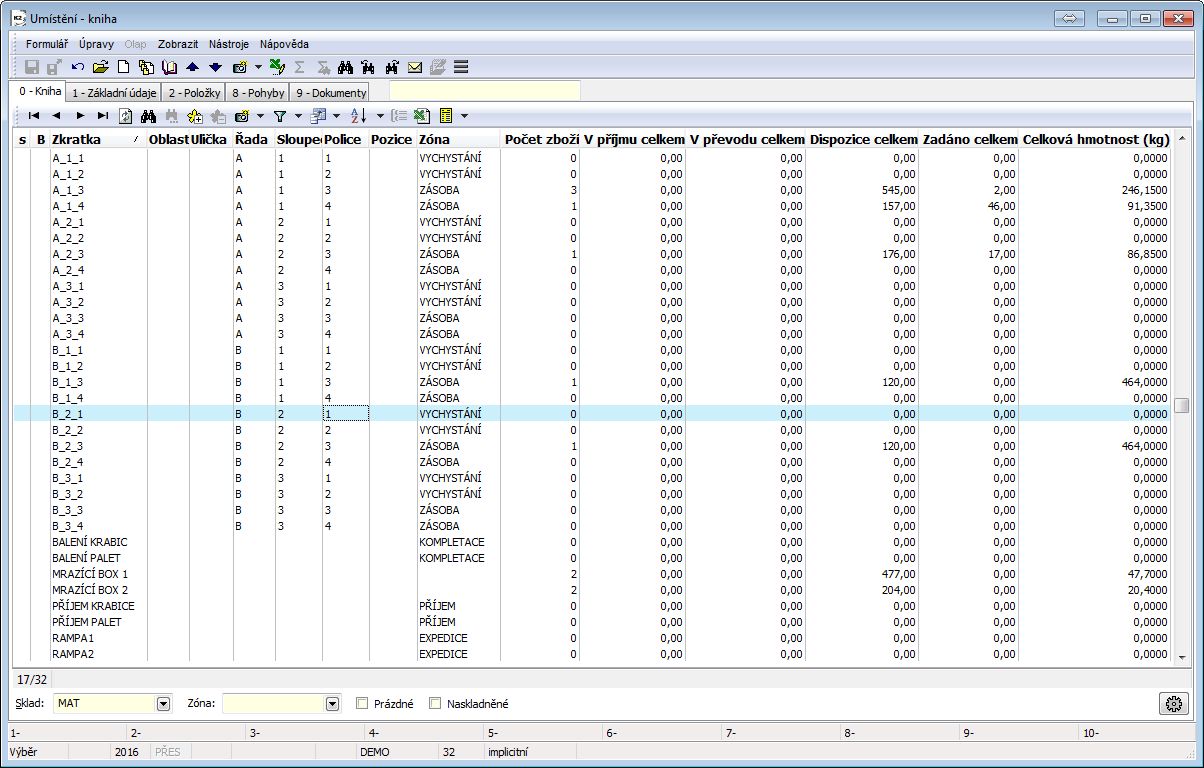
Picture: Locations book (global description)
Field Description:
Whse. |
Required warehouse for stock records monitoring. |
Zone |
Required zone of warehouse. |
Empty |
Displays locations that are completely empty in the relevant warehouse (they do not contain any items; In Receipt, In Transfer, Received, Availability, Entered, Expedition are zero). |
Stock up |
Displays the locations that are stored in the relevant warehouse by items (they are not empty; In receipt or In transfer or Received or Availability or Entered or Expedition are non-zero). |
Non-zero |
Selection is displayed just in case the book Locations is activated for the specific article card. In those locations are displayed in the list where the non - zero status of the respective articles is registered (V receipt or In transfer or Received or Availability or Entered or Expedition are non-zero). |
Unit |
Selection is displayed just in case the book Locations is activated for the specific article card. It offers the selection of stock items of articles where the stock information are stated. |
|
Configuration of formats for creation of location abbreviation. The location abbreviation can consist of the following elements: area, aisle, row, column, shelf, position. Set the required number of signs which must be from 1 to 3 signs upon each member that you need to use for abbreviation structure. You can set a separative mark - breakpoint for each member as well. You can add a format to the Location card. In this case upon record saving there is checked if the location abbreviation meets the given format. |
Selected fields' description:
In receipt |
It contains the amount of receipts notes from unconfirmed stock documents (positive item of receipt, negative item of issue, negative item of the receipt with the flag "v", item of the stock transfer with the flag "v"). |
In transfer |
It contains the income part from internal transfers notes (i. e. from transfers notes within one warehouse). It is only counted if the location changes by transfer. |
The significance of these fields is primarily for the automatic proposal of placements for income, when it is necessary to evaluate the extent to which the placement is available at the relevant moment on the basis of already existing income items on unconfirmed documents.
Create location in bulk
Function is activated from menu Form / Action. Firstly, choose the required format configuration of location abbreviation and then set the extent for creation of the followed members. The following step is to generate the list of locations which are going to be created. You can create new locations by Generate button. The function is available just for the Users with the right Code lists / Location / Bulk generate and delete location.
Delete location
The function is activated from the menu Form / Bulk actions. It is possible to delete marked locations by stars. Just locations which are not used in items of stock documents can be deleted. The function is available just for the Users with the right Code lists / Location / Bulk generate and delete location.
Invalidation of location
Locations that are empty can be canceled (with the F8 key).
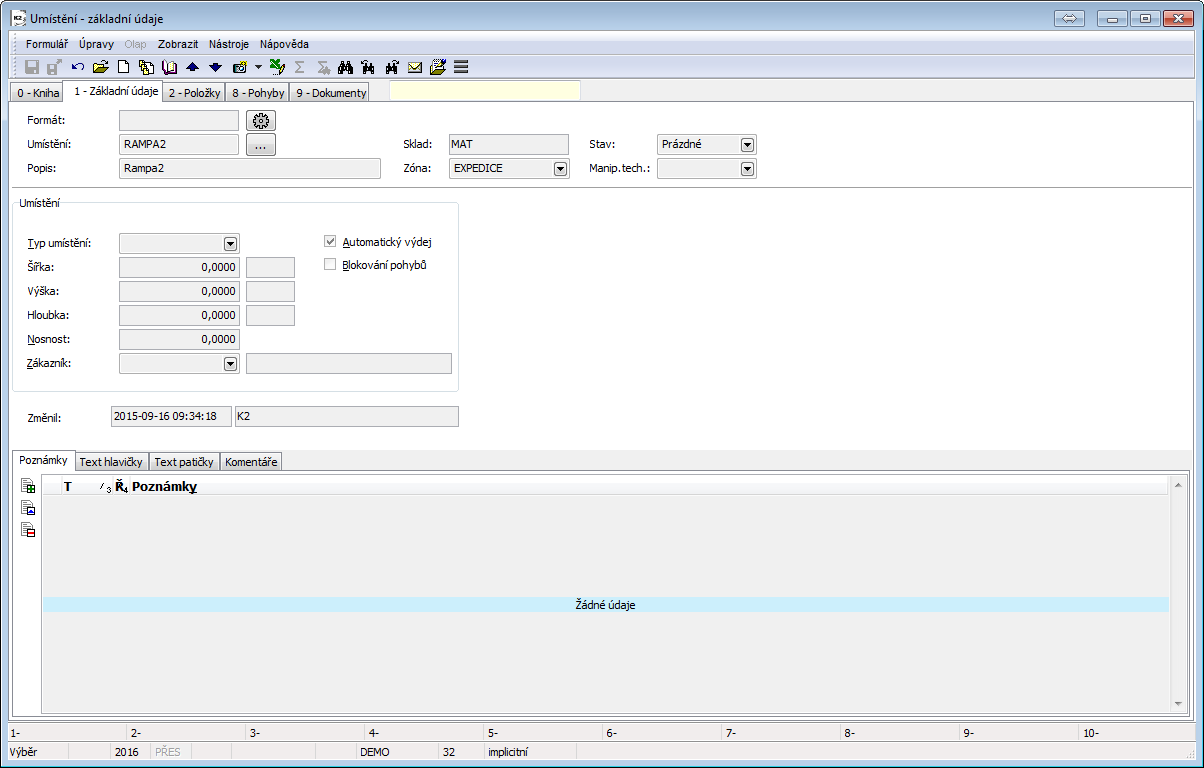
Picture: Location - Basic data
Description of Fields in Document Heading:
Format |
By button |
Location |
A location abbreviation. If the format is set for location, then the abbreviation structure is controlled upon saving if it meets the selected format. If not, then the record cannot be saved. The abbreviation can be set by pressing the button |
Description |
Description of a location. |
No. |
A location number. |
Whse. |
A warehouse abbreviation where this location links. |
Zone |
The zone to which the location belongs. |
Handling equipment |
Handling equipment, that should be used for logistics operations at a given location. |
Fields description of a Location part:
Location type |
Location type. You can define a width, a height, a depth and a load rating. |
Width, Height, Depth, Load rating |
The data displayed from a defined location type. |
Customer |
Link to the Customer/Supplier book. Thus, for example, you can determine which customer's location is in the warehouse. |
An automatic release |
The option that defines if the location is possible to enter automatically to the releases items. The field is activated default when creating a new location. |
Block movements |
Block movements at a given location. Blocking is checked for confirmation / undo confirmation of stock documents (receipt cards, release notes, transfer notes, job cards). |
Fields description of a Articles part:
This field is displayed just in case the book of Locations runs for the specific articles (in the book of Articles or from the item of the document).
Article abbreviation 1, 2, Article name |
Identification of the article where you exactly activate the form. |
Received, Available, Assigned |
The actual information about stock level of an articles on an appropriate location. |
On the tab 2 - Items, the table lists all the Article tabs that are currently in the respective location. Using the options Show order code and Show batches, the available and entered data can also be broken down according to auxiliary stock records.
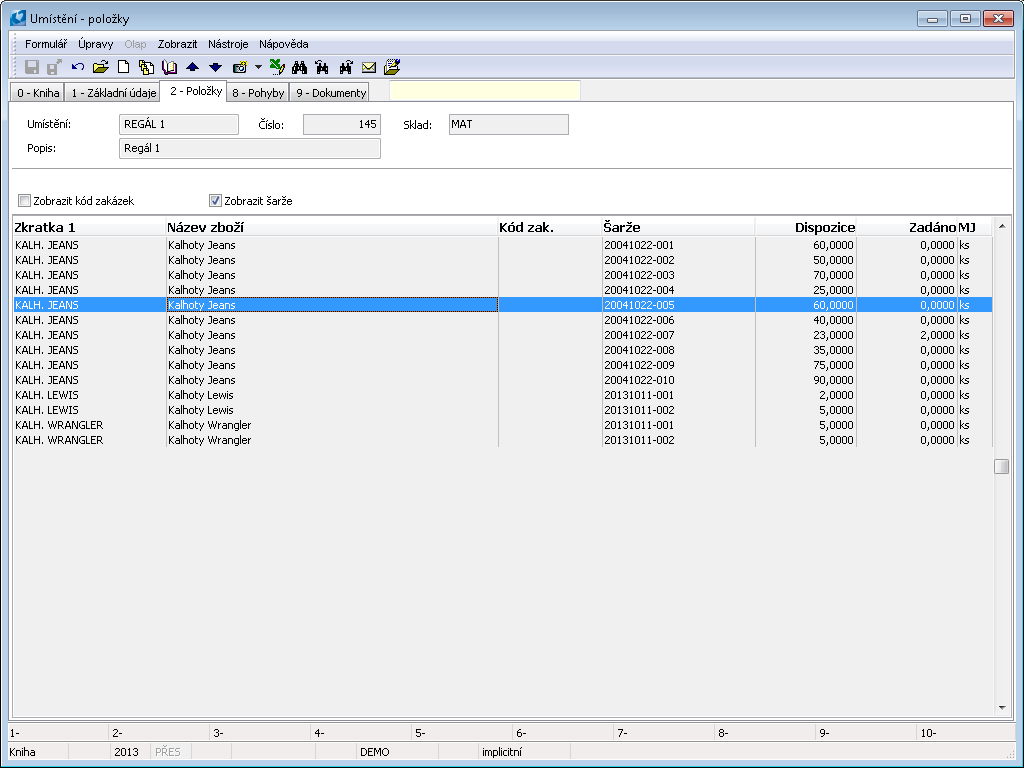
Picture: Location - Items
The tab 8 - Movements shows the stock storage card for the selected period. By selecting an item in the Article field in the form header, only the movements of the selected article card can be displayed.

Picture: The Location book - Movements
On 9 page of Location can be same as In other modules assign document to location. (Further work description with Documents is in Basic Code Lists and Supporting Modules K2 – 9th Page chapter).
Handling Units
A handling unit is an article or a group of articles which creates a unit capable of manipulation without any other modifications. Typical handling units for the manipulation with articles in terms of stock are for instance pallets, containers, boxes, carts, etc.
Book of Handling Units
In the book of Handling Units, you can register the cards of manipulated units (pallets, carts, containers etc.). A manipulated unit can be understood as a moving stock location. A handling unit is also used to record the items of articles. Each handling unit may contain only the articles recorded in one stock and one location at the same time, i.e. a handling unit is always located on one specific place in the warehouse.

Picture: Book of Handling Units
Fields' Description:
Stock |
Required warehouse for stock records monitoring. |
Empty |
Displays handling units that are completely empty, i.e. do not contain any items; field Number of article = 0. |
Stock up |
Displays handling units that are not empty, i.e. contain at least one items; field Number of article> 0. |
Non-zero |
This option is available only if the book of Handling Units is opened for a particular Article card. The list will show only those units on which a non-zero level of the given article is recorded (In Receipt, In Transfer, Received, Available, Assigned or Dispatch are not null). |
Unit |
The field is available only if the book of Handling Units is opened for a particular Article card. It offers the option of article stock unit, in which the stock information will be stated. |
A description of selected default columns upon opening the book without articles:
Stock, Location |
Current location of a handling unit in the stock. This means that all the items of articles are in this place in the stock. |
Total Available, Total Assigned |
Available and Assigned for all the articles on the handling unit. Information is loaded according to the set stock. |
Number of Articles |
The number of various Article cards on the handling unit. |
Total Weight (Kg) |
The weight of all the articles on the handling unit. |
A description of selected default columns upon activation of the particular article (from the book of Articles, from the item of document):
Available, Assigned |
Available and Assigned of a given Article card which the code list was opened for. Information is loaded according to the set stock. |
If a handling unit is empty, you can invalidate it (F8).
Basic data of a handling unit.
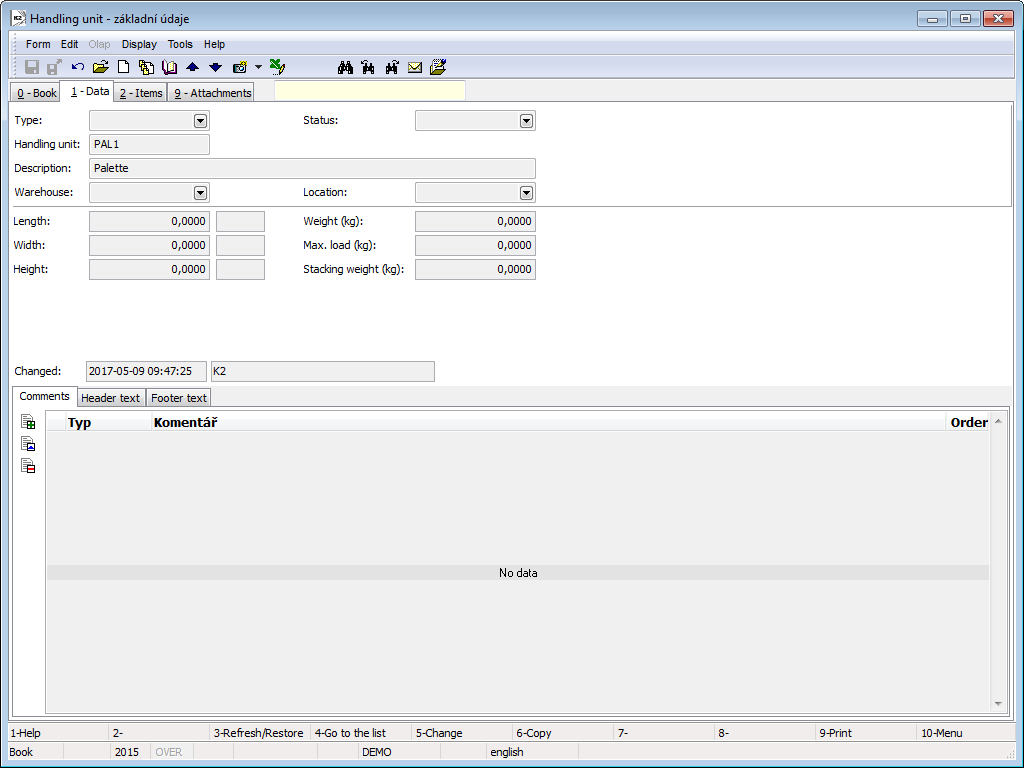
Picture: Handling unit - Basic Data
Fields' Description:
Type |
Type of Handling units A closer description follows in the text. |
Handl. U. |
A unique identification of a handling unit (abbreviation). Creating an abbreviation may be automatized by settings in the Handling Unit Type. In this case, an abbreviation in the format "@AUTO@" will be generated in a new card after you choose the type. Upon saving, it will be rewritten according to the settings in a unit type. |
Description |
Description of a handling unit. |
Stock, Location |
Current location of a handling unit in the stock. This means that all the items of articles are in this place in the stock. If the handling unit is not empty, the fields are read only. If the unit is empty, the fields may be edited. |
Length, Width, Height, Weight, Loading Capacity, Stackability |
Values valid for a handling unit. They are only displayed in a handling unit, the attributes of the unit are defined in the Handling Unit Type. |
Type of handling units.
Handling unit type serves for pre-setting the data that are valid for the specific group of handling units. Then you can define the rule for an automatic creation of handling unit abbreviation.
Fields' Description:
Length, Width, Height, Unit |
Defining the size of a handling unit in a chosen length unit. |
Weight (Kg) |
Weight of a handling unit in kilos. |
Loading Capacity (Kg) |
Loading capacity of handling unit in kilos. |
Stackability (Kg) |
Maximum of stackable weight in kilos. It defines (e.g. in containers) how many kilos the container can carry, i.e. how many other fully loaded containers. |
Prefix, Number From, Number To |
It enables to define the structure of generated abbreviation of a handling unit. A unit abbreviation is created as a Prefix + Ordinal Number in terms From - To. |
Current Number |
It displays the currently used number when the abbreviation of a handling unit is generated. If needed, the number can be changed by the user. |
This page shows the currently saved items on / in a handling unit.
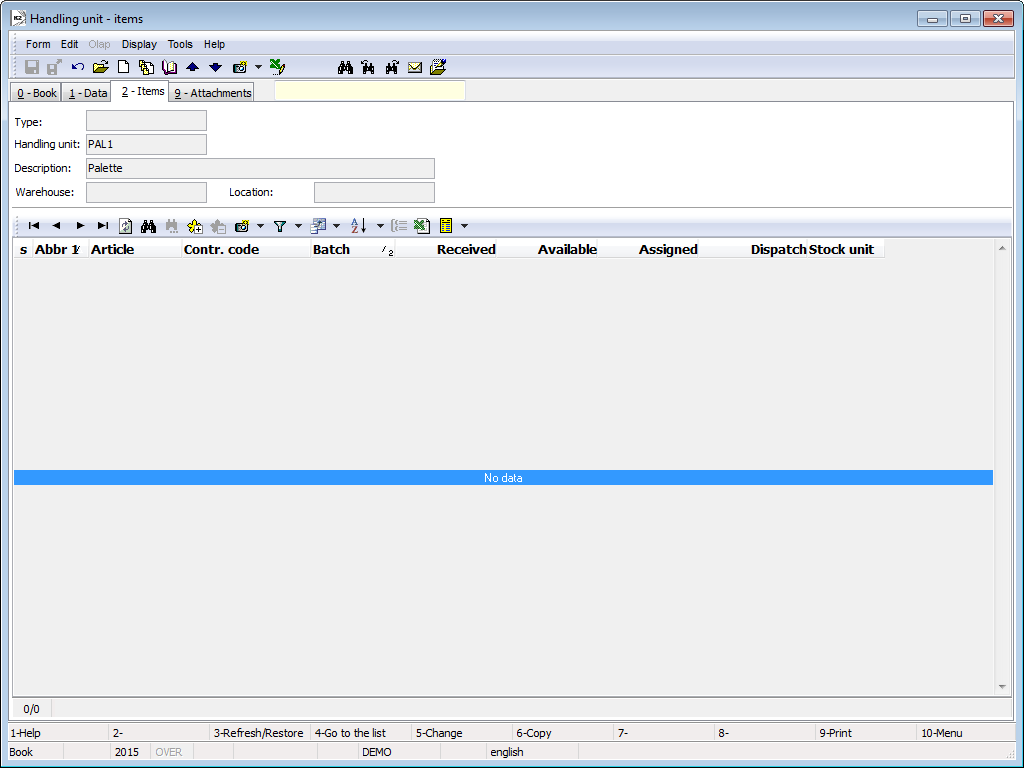
Picture: Handling units - Items
Articles
Description of the Article book is stated in chapter Basic Code Lists and Supporting Modules K2 – Article.
From the point of view of warehouse records, it is important to explain the terms current warehouse and current period especially for the print of reports in the Warehouse module, and (in the lower part of the book of Articles) the fields Warehouse, Plan Type and the data about aPhysical Warehouse.
Fields' Description:
Stock |
Current warehouse which are all the information taken from. It is also called the "information warehouse". Data about articles states that you can see in the screen are from a current warehouse. The abbreviation of a current warehouse is displayed in the upper blue bar on the screen as well. The current warehouse can be changed directly in this field or with the Alt + F10 key. The Set period and stock form will be displayed by this way where you can set a period and a current warehouse in the Warehouse field. |
Physical Warehouse |
A warehouse that is entered to stock documents by default if those are linked with a superior document (a Sales Order, a Purchase Order). The actual movements of articles will then happen in this warehouse. A physical warehouse shows in the lower status bar. It is changed automatically according to the information warehouse. It can also be changed independently of the information warehouse by clicking the right mouse button in the status bar over its current value. |
Current Period |
Display interval of stock records. The Display Interval may be opened with Alt+F10 on page 0, 6th, 7th, and 8th page of the Article card. There you can set the current period in the fields Period From and Period To. In The book (on page0), you can only change the Period To field. |
Plan Type |
Information about the current state of articles for a selected plan type will appear in the book of Articles in the columns Assigned, Reserved, and Ordered based on how it is entered in the items of documents of Sale, Purchase, production, or stock. |
Book of Stock Items By Periods
The book of Stock Items By Periods shows the states of articles in allocation to auxiliary stock records - batch, contract codes, location (the same as the function Stock Wizard(Ctrl+F6) for a particular card in the book of Articles). In the "Book" state, all non-zero records of stock record will be loaded (non-zero values in the columns Received, Available, Assigned, Dispatch). The displayal of records respects the warehouses of own company (depending on the settings of displaying own companies and the settings of the Display Warehouses of All Own Companies right).
The book may be activated only by users authorized in Code Lists / Articles / Browse Articles. Stock levels can be displayed to periods. A period is set with the ALT+F10 key combination. Setting of a period is the same as in the case of the book of Articles.
Note: The accounting value is not calculated to previous periods in stocks with a sliding price.
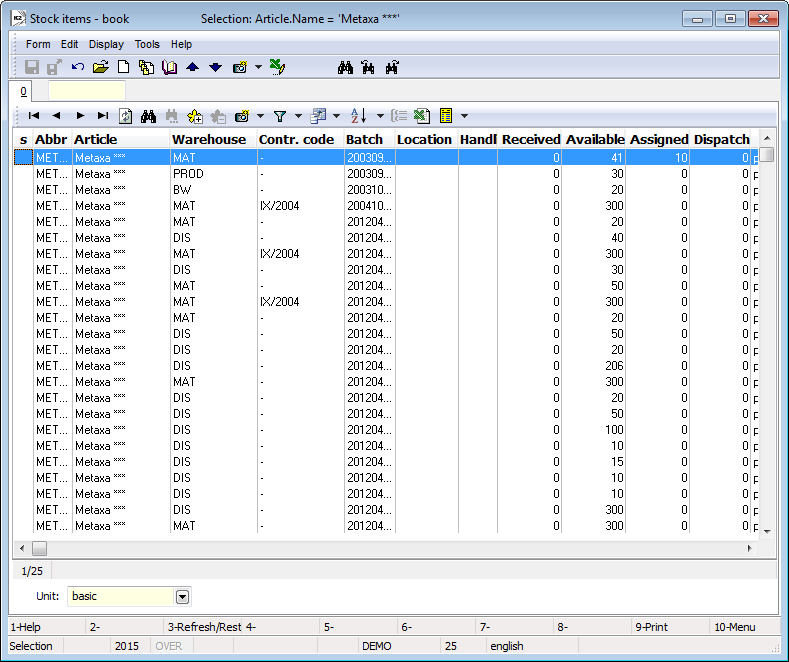
Picture: The Book of Stock Items By Periods
Serial Numbers
The book of Serial Numbers displays all the serial numbers which occur in the K2 documents.

Picture: The Book of Serial Numbers
How to activate the book:
- by pressing the button from the desktop or the tree menu;
- with the use of the Ctrl+Alt+F7 combination for a particular serial number from the 6th page of documents of Purchase, Sale, Job Cards, Transfer Cards, and from the 1st page of Service Sheets (over the Serial Numbers tab).
The list of serial numbers may be limited to serial number available in stock only, by activating the Available Only option which can be found in the bar over the list on page 0.
You can create a new Service Sheet from the book via the Ctrl+Shift+F8 key combination, in which the articles and serial number, which the light indicator is positioned on, will be pre-filled in. Furthermore, the data about the sale from the last Invoice Out will be pre-filled in. However, the function is not available if the serial number has never been sold before (i.e. is not on any Invoice).
Page 1 - History
Displays the history of a serial number. The current state of a serial number in stock is stated in the heading.
Using the Display Non-Stock Documents option enables you to display the location of a serial number on Purchase Orders and Sales orders, if the item does not have a stock document yet. Planning Job Cards are also displayed as a non-stock document. Using the Display Service Sheets option enables you to display the location of a serial number on a Service Sheet.
The Invoice number bound with the stock document is also loaded to the items of Purchase and Sale as an information. This can be displayed with the "SNBA_CFInvoiceDocID" column.
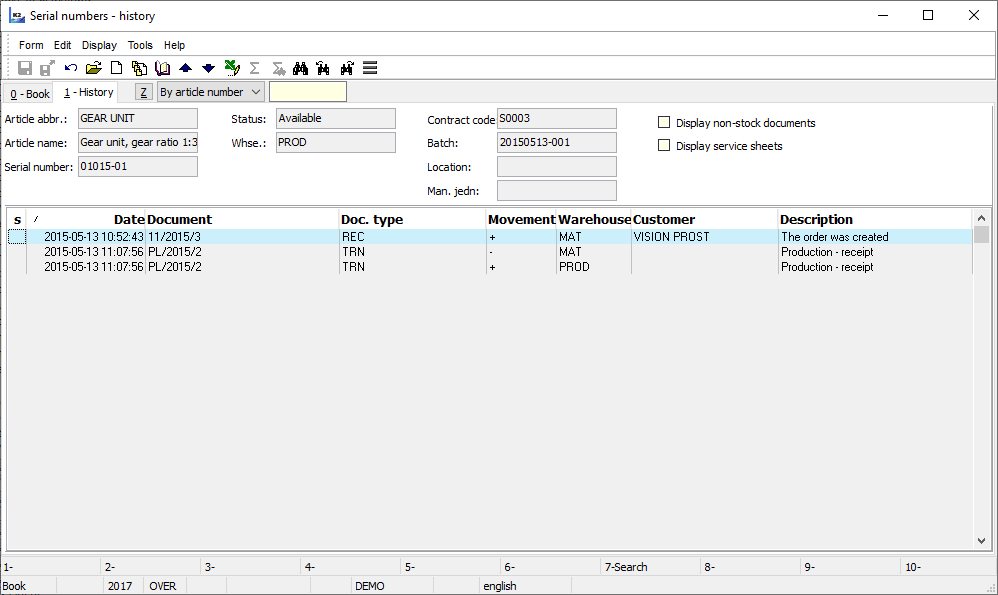
Picture: Book Serials Numbers - page 1- History
Transfer notes
A Transfer Note is a document about a transfer of goods from one stock to another, the change of its location to another within one stock, or from a contract code to another contract code. Transfer Notes enter accounting.
The transfer of articles is executed after confirming the document. If the option Double Confirmation of Transfer Notes is active in the Book of Warehouses, the program will require a double confirmation of Transfer Notes in two steps. The first confirmation disables performing other changes in the document (you can change only some data in items), the transfer itself will only be finalised after the second confirmation.
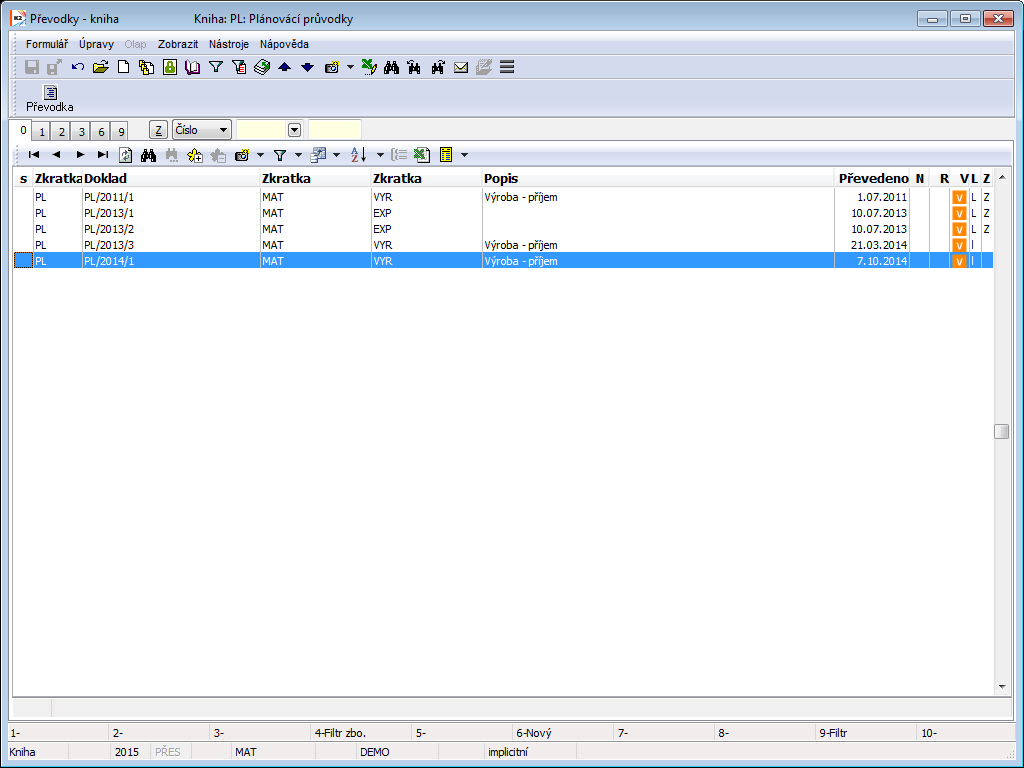
Picture: Book of Transfer Notes
Book of Transfer Notes
On the 1 st Page of Transfer notes, basic data are stated related to the whole document.
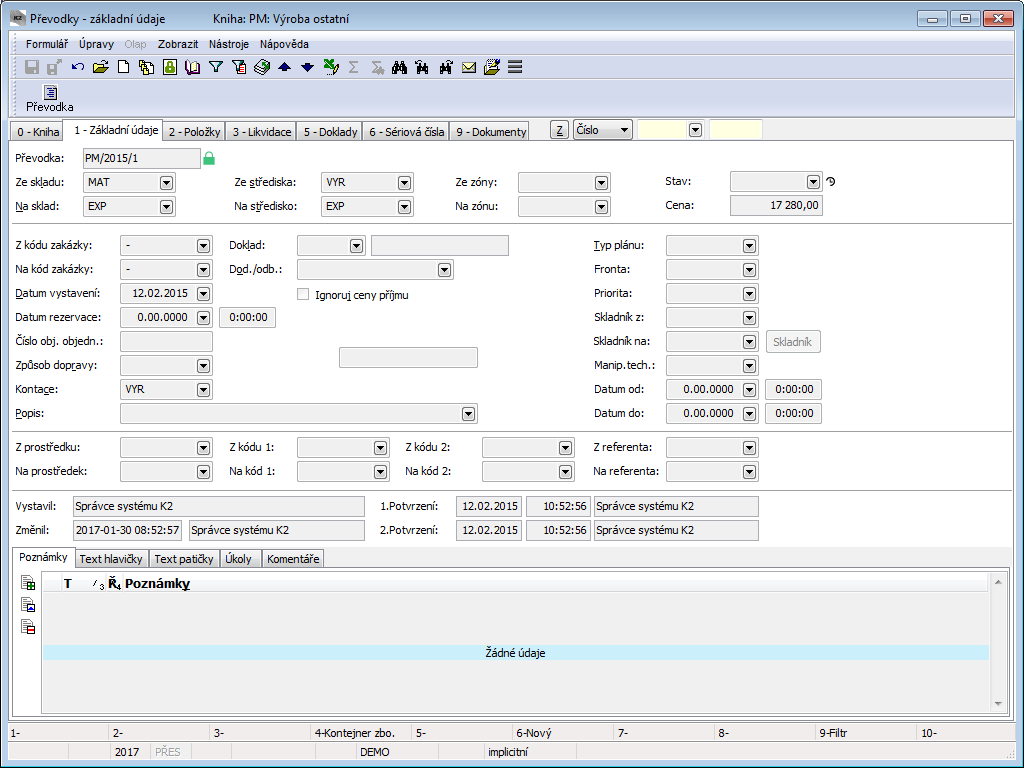
Picture: Transfer notes - 1st Page
Fields' Description:
Transfer Note |
Transfer Note identification: Book / Period / Number |
From Warehouse |
The warehouse from which the items of a Transfer Note are transferred. If there is a releasing warehouse pre-set in the Books of Warehouses, it will be filled in automatically. Filling in the field From Warehouse will automatically fill in the corresponding cost centre into the From Cost Centre field. |
From Cost Centre |
A cost centre of a releasing warehouse. It is filled in automatically together with setting the warehouse. |
From Zone |
Stock zone which the items will be transferred from. If the releasing zone is preset in the Books of warehouses, then it is completed automatically. The Offer content is filtered according to settled releasing warehouse. |
To Warehouse |
The stock where the items of transfer notes are transferred from. If the releasing stock is preset in the Books of warehouses, then it is completed automatically. Filling the field Stock level the appropriate cost centre will be set into the field To Cost centre. |
To Cost centre |
Cost centre of incoming stock. It is filled in automatically together with setting the warehouse. |
To Zone |
The zone of a warehouse to which the items will be transferred to. If a receipt zone is pre-set in the Books of Warehouses, it will be filled in automatically. The contents of the zone options is filtered according to the receipt warehouse. |
Status |
Status of document. The field can be completed with the figure from user defined code list. Importance of that field is mainly for making interconnection with Workflow processes. The field has an evidence of historical changes. |
Price |
Total price of a Transfer Note. |
From Contract Code |
Pre.setting a contract code for items - release page. |
To Contract Code |
Pre-setting a contract code for items - receipt page. |
Date of Issue |
The date of doc. issue. The current date is set automatically here, but it can be changed. |
Reservation Date |
The date of reservation, i.e. the date of a requirement for transfer. |
Order No. of Customer |
The number of a customer's order. |
Method of Transport |
A reference to the Mode of Transport code list. |
Posting Key |
A posting key of a Transfer Note. If a posting key for Transfer Notes is pre-set in the Books of Warehouses, it is completed from the corresponding book. |
Description |
User description of a document. |
Document |
You can attach any documents of Purchase or Sale, a Job Card or a Transfer Note to the Transfer Note and paste the items from this document to the Transfer Note. However, you can only copy the Article cards from Job Cards that have the option Transfer Notes / Job Cards Linkage active in their Article Category. When copying items from the documents of Purchase, the auxiliary stock records of the original item are also copied into the items. The dimensions of the auxiliary stock records are not copied from the documents of Purchase. The values of the page "From" in the items of a Transfer Note are pasted into the "To" page. |
Suppl./Cust. |
A customer for whom we create a Transfer Note (upon the selection of a Sales Order, the information will be filled in automatically from the Sales Order's header). |
Ignore receipt prices |
If the option is active, the receipts to stock will be valued according to the method of stock valuation (to which the receipt is done), i.e. the item will be valued the same way as in the case of a release. Activating this option will deactivate the check of multiple batch receipt. |
Plan Type |
This field serves for another division of documents (see Plan Type). |
Queue |
The queue to which the document is assigned for processing. An example of a queue may be to divide warehousemen into certain groups. By entering the queue in a stock document, an order number for an assignment to processing within the assigned queue will be generated when the document is saved. |
Priority |
The document priority for adding into a job queue. |
Warehouseman From / Warehouseman To |
A warehouseman for the release and the receipt pages of a document. Select a warehouseman from the Officers book. |
Date From / Date To |
A time interval in which a warehouseman performed an assigned logistic task (transfer). |
From Vehicle / To Vehicle |
The Vehicle analytical axis. |
From Code 1 / To Code 1 |
Analytical dimension Code 1. |
From Code 2 / To Code 2 |
Analytical dimension Code 2. |
From Officer / To Officer |
The Officer analytical dimension. |
1st Confirmation confirmation, |
Date, time and the name of the K2 user who confirmed the record. |
Issued By |
The name of the user who issued the document. |
Changed |
The date and name of the user who made the last change to the record. |
It is possible to work with notes on this page in the same way as with the other IS K2 modules. Further work description with notes is stated in the chapter Basic Code Lists and Supporting Modules K2 – Notes.
The items of the document are placed on the 2ndpage of Transfer Notes.
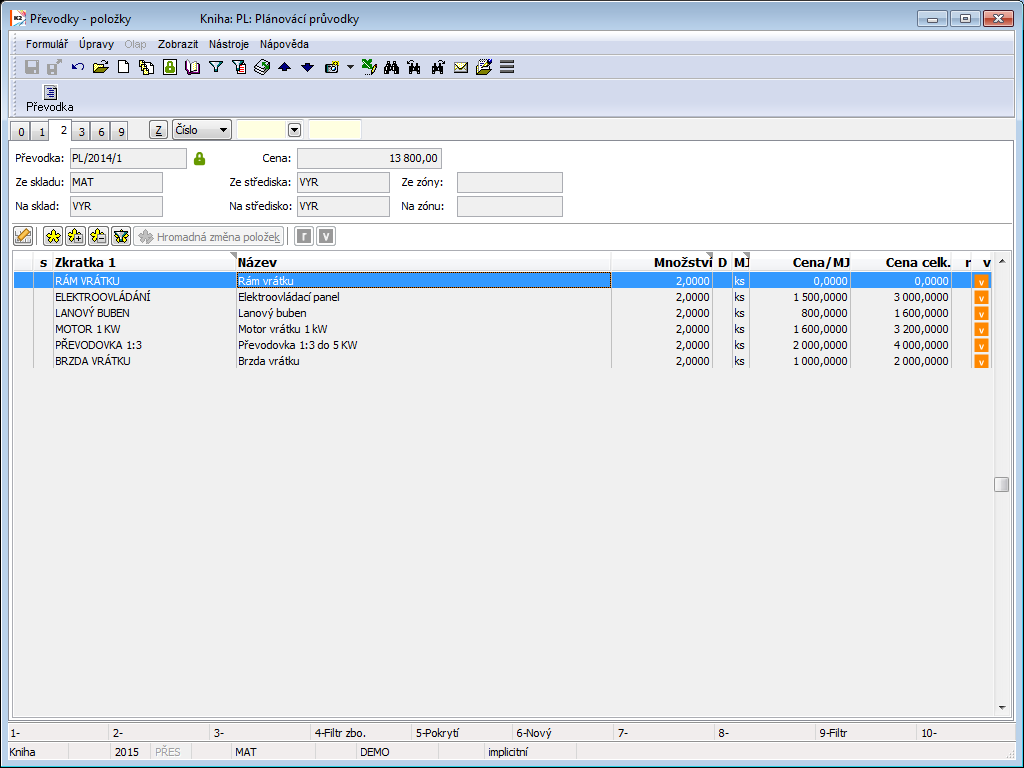
Picture: Transfer notes- 2nd Page
Items are inserted into Transfer Notes in a typical way with the Ins key. You may also make use of the bulk entering via Shift+F6 described in the chapter Inserting of New Items To Superior Document. You can also activate the row editing in Transfer Notes as in the documents of Purchase / Sale with the button  .
.
Note.: You can load the items to a Transfer Note from any document of Purchase and Sale or from a Transfer Note by assigning a selected type of document to a given Transfer Note (on the 1st page of a Transfer Note, the Document field, button Document). After approving the query asking whether you wish to copy the items, the items will be copied to the 2nd page of a Transfer Note. However ,only the items of the article category that has a permitted link of Transfer Notes and Job Cards (the Article Category code list, option Linkage Between Transfer Notes and Job Cards) may be copied from Job Cards.
A new item of a Transfer Note automatically gets a flag ![]() of release Such item will be transferred and represents the record in coverage of the "Assigned-TRN" (from the perspective of stock from) and "Receipt-TRN" (from the perspective of stock to). In the case of an internal Transfer Note within one stock, there are the following records in coverage: "internal-TRN" (for the release side) and "in transfer" (for the receipt side)*. The flag of release may be deactivated, or re-activated by using the Alt+V key combination, or by pressing the button
of release Such item will be transferred and represents the record in coverage of the "Assigned-TRN" (from the perspective of stock from) and "Receipt-TRN" (from the perspective of stock to). In the case of an internal Transfer Note within one stock, there are the following records in coverage: "internal-TRN" (for the release side) and "in transfer" (for the receipt side)*. The flag of release may be deactivated, or re-activated by using the Alt+V key combination, or by pressing the button ![]() in document heading. If the flag in a subordinate document is deactivated, the item will not be transferred. Deactivating the "v" flag can be used to prepare an article item for transfer, even if it does not have a sufficient availability in stock at that moment. A Transfer Note with an item without the "v" flag cannot be confirmed. If the situation occurs where there are existing items that cannot be transferred at the moment and items with the "v" flag that you already need to transfer, you can split the Transfer Note and create a new one, which the items without the "v" flag will be moved to - this is where the Split function comes to help. It can be activated with the Ctrl+F6 combination in the Browse mode.
in document heading. If the flag in a subordinate document is deactivated, the item will not be transferred. Deactivating the "v" flag can be used to prepare an article item for transfer, even if it does not have a sufficient availability in stock at that moment. A Transfer Note with an item without the "v" flag cannot be confirmed. If the situation occurs where there are existing items that cannot be transferred at the moment and items with the "v" flag that you already need to transfer, you can split the Transfer Note and create a new one, which the items without the "v" flag will be moved to - this is where the Split function comes to help. It can be activated with the Ctrl+F6 combination in the Browse mode.
The items without the flag of release may be marked with the flag ![]() of reservation This can be done via the Alt+R key combination or by pressing the button
of reservation This can be done via the Alt+R key combination or by pressing the button ![]() in document heading. This way we obtain information about the items which we want to transfer. In coverage they are deputised by a "reserved-by transfer note" type (from a point of stock view from) and "ordered-by transfer note" type (from a point of stock view on). The items of an internal Transfer Note with the "r" flag are ignored for the coverage. * You can change the "v" flag to "r" flag at items with no availability on the set combination by running the function of check of release - use the F4 key to check all items of the document (Test v), use the Shift+F4 combination for a specific item of the document (Test v1). If possible, the program itself replaces the "v" to "r" sign in case of no availability when saving.
in document heading. This way we obtain information about the items which we want to transfer. In coverage they are deputised by a "reserved-by transfer note" type (from a point of stock view from) and "ordered-by transfer note" type (from a point of stock view on). The items of an internal Transfer Note with the "r" flag are ignored for the coverage. * You can change the "v" flag to "r" flag at items with no availability on the set combination by running the function of check of release - use the F4 key to check all items of the document (Test v), use the Shift+F4 combination for a specific item of the document (Test v1). If possible, the program itself replaces the "v" to "r" sign in case of no availability when saving.
*) The matters of internal Transfer Notes and their deactivation from the viewpoint of their behaviour for calculating stock records and coverage are described in the Internal Transfer Notes - Specifications.
Transfer Note flags:
|
Transfer from stock. |
|
Reservation of a transfer. |
The Bulk Change of Items button in the heading of the second page of the document serves for bulk change of data in selected items. A general description of the function is provided in the chapter Bulk Change of Document Items. The button is available also after the first confirmation of a Transfer Note. In this situation, however, it offers only some data: the particular field To Location and To Handling Unit. This change means that although the Transfer Note has been confirmed for the first time, it has not transferred the articles, and the person responsible for the reception needs to know the location of where the articles are to be stored.

Picture: The Transfer Note Item form
Fields' Description:
EAN |
EAN code. |
Articles |
Selection of goods from the book of Articles. |
Description |
An additional name of an article. |
Reserved |
Setting of the reservation flag. |
Released |
Setting of the release flag. |
Variant |
Selection of a variant of product routing. |
From Contract Code |
The contract code that the articles will be transferred from. By default, the contract code from the 1st page of the transfer note from field From Contract code. |
To Contract Code |
A new contract code that that the article is transferred to. |
Batch |
Batch of transferred articles. |
From Location |
Location that the goods will be transferred from. |
To Location |
New location that that goods is transferred to. For an automatic suggestion of a suitable placement, the rules described in the Basic Article Data, field Location - Auto, apply. After changing the quantity in the Transfer Note item, a new suggestion of location may be done with the button Note: In the case of double confirmation of Transfer Notes, this field is not checked after the first confirmation. Location may be then field in before the second confirmation with the Bulk Change of Items button. Note 2: Pay attention to a different functionality when choosing the record from the Wizard's offer (button '?'). Selecting a record will not complete the whole valid combination of an auxiliary stock record into the item, but only the location. |
From Handl. Un. |
A handling unit which the articles are to be transferred from. |
To Handl. Un. |
A handling unit which the articles are to be transferred to. Note: In the case of double confirmation of Transfer Notes, you can also enter the handling unit before the second confirmation with the Bulk Change of Items button. Note 2: Pay attention to a different functionality when choosing the record from the Wizard's offer (button '?'). When you select the record then the combination of stock helping evidence will not be set into the item but just handling unit. |
However From Code 1 / To Code 1 |
Analytical dimension Code 1. |
From Code 2 / To Code 2 |
Analytical axis Code 2. |
From Cost Centre / To Cost Centre |
Analytical axis Cost centre. The fields are obligatory. After filling in the cost centres into a new item, it is being analysed whether the articles have a cost centre defined on their card; if not, the cost centre is taken from the Transfer Note header. |
Unit |
Stock unit item of product. |
Quantity |
Transferred amount. |
Required Par. |
Required parameters of batch. |
Posting Key |
Posting key of a Transfer Note item. If you do not set a posting key, a pre-set posting key from the 1 st page of a Transfer Note will be completed into the document after the confirmation. |
Original code |
Article code. It is set from the 1 st page of an Article card. It only displays in this field. |
Article code |
A new Article Code of transferred Articles. |
Price from a stock |
A price the article is sold for. A planned stock price is set after inserting the item. After the confirmation of a Transfer Note, the price is set according to the method of stock evaluation. |
Price To Stock |
A price which the article is received for. A planned stock price is set after inserting the item, after confirmation it equals the release price. If you check the Ignore the Receipt Price option, the receipt is valued according to a method of evaluation of the stock to which the receipt is being done. |
From Vehicle / To Vehicle |
The Vehicle analytical axis. |
From Officer / To Officer |
The Officer analytical dimension. |
Plan Type |
Selection from the Plan Type code list (see the description of the 1st page of a Transfer Note). |
Supplier |
Supplier selection. |
The 3 rd page of the Receipt Card is used to assign and post the document. This issue is described in details in the chapter Accounting - Account Assignment and Posting.
The serial numbers set in the Transfer Notes field are displayed on this page. Detailed description of work with the serial numbers in the stock documents is provided in the chapter Shared Purchase and Sale Elements - Serial Numbers.
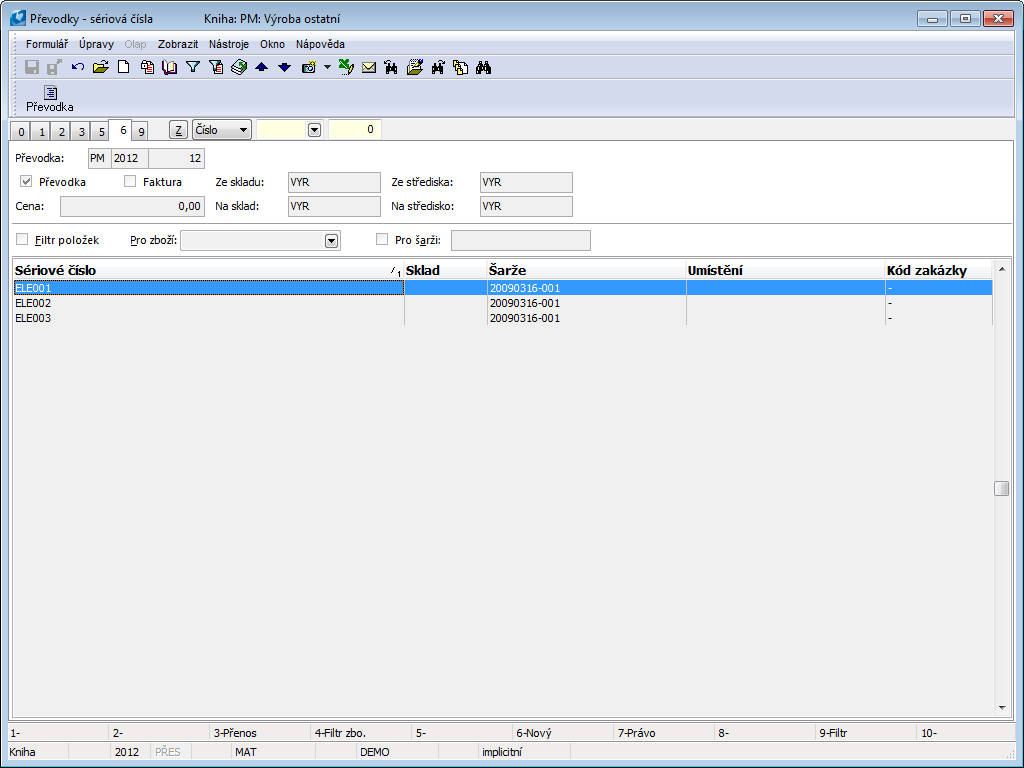
Picture: Transfer notes - 6th Page
On the 9 st Page is possible to Receipt cards assign any attachments and documents. Further work description with attached documents and ext. documents is stated in the the chapter Basic Code Lists and Supporting Modules K2 – 9th Page ).
Internal Transfer notes - particularity
Internal Transfer note is a Transfer note in one stock (e.g. Transfer from location to location, from a handling unit to another handling unit).).
The particularity of unconfirmed internal Transfer notes:
- Blocking of Articles and of a stock auxiliary evidence (Assigned calculation- an item with "v" sign):
- A header of an Article is not blocked (do not enter into Assigned);
- Those axes which are changing by transfer (e.g. During the transfer from location to location the amount of Assigned will be calculated just for location);
- Receiving part of a stock auxiliary evidence (calculation In transfer- an item with "v" sign):
- the In transfer field contains the receiving part from the internal transfer notes and is calculated only for the axes that are changed by the transfer (the "On" side is different from the "From" side);
- Coverage:
- The items with "r" signs are ignored, they do not have any reflection in Coverage;
- in Coverage the items with "v" signs are represented by "internal-transfer note" type for releasing part and “In transfer” for receiving part;
- Ordered, Reserved in the book of Articles:
- items of ordered and reserved amount do not enter into calculation;
This specific behavior for internal transfer notes can be turned off by using the clients parameter Internal transfer notes to count to Entered. In this case, transfer notes within one warehouse behave as standard (as transfer notes between warehouses).
Functions Over Transfer Notes
F7 |
Posting a Transfer Note. This is done over the Evaluation filter. The functions of account assignment and accounting are described in detail in the chapter Accounting - Account Assignment and Posting. |
F4 |
The function of a release test. It evaluates the possibility of release of all items with the 'v' flag, and if some of the items cannot be release, it replaces the flag of release with the flag of reservation 'r'. The function may be activated on the 2nd page in the Change mode. |
Alt+F2 |
Document confirmation. If there is an item without the "v" flag, it cannot be confirmed. |
Alt+F5 |
All V+. Bulk assignment of the "v" release flag to all items. If it is not possible to assign the flag of release due to insufficient availability, the "r" flag of reservation will be assigned instead. The function is activated on the 2nd page in the Change mode. |
Alt+F5 |
Change stock price - on 2 Page of confirmed document. |
Alt+F6 |
Release from handling unit. The function serves to insert all items from the selected handling unit into the document (page 2 in the Change mode). |
At+F7 |
All R+. Bulk assignment of the "r" reservation flag to all the items. The function is activated on the 2nd page in the Change mode. |
Ctrl+Enter |
If field Suppl./Cust. Is filled, on 1 st page will open In Browse Suppl./Cust. book. On the 2 nd page in the Browse mode and in the Change mode, it opens the book of Articles and sets the light indicator to the item which the indicator is set on in the Transfer Note items. |
Ctrl+F5 |
Change Confirmation Date The Check negative level option allows you not to allow the date change if a negative level should occur in the stock record. The users without the right Code lists / Articles / Set "Negative stock level allowed" checkbox have the option enabled and cannot change it. Note: The negative level in the serial number records is not checked. |
Ctrl+F5 |
All V-. Bulk assignment of the "v" release flag to all the items. The function is activated on the 2nd page in the Change mode. |
Ctrl+F6 |
Assign batches and locations to the items of release (page 2 in the Change mode). The functionality is identical to the functionality of the program when the option Add batches and locations to expenses while saving is activated in the specific Book of warehouses |
Ctrl+F7 |
All R+. Bulk assignment of the "r" reservation flag to all the items. The function is activated on the 2nd page in the Change mode. |
Ctrl+F6 |
Separation of a stock document. This creates a new Transfer Note and transfers all the items without the "v" flag (from a current Transfer Note) into the newly created Transfer Note. |
Ctrl+F7 |
Account assignment and posting of a Transfer note. This is done over the Evaluation filter. |
Shift+F4 |
Fills in an article container with the Transfer Note items. The function may be launched on all of the pages in the Browse mode. |
Shift+F4 |
The function of a release test for one item. It evaluates the possibility of releasing of a topical marked with "v" sign. If the item cannot be released, the release flag is replaced by the "r" flag of reservation. The function may be activated on the 2nd page in the Change mode. |
Shift+F5 |
Coverage of a demanded article - on the 2nd page of the Change mode and the Browse mode. This function is described in more detail in chapter Basic Code Lists and Supporting Modules K2 – Articles - Coverage of article demanded. |
Alt+F2 |
Confirmation of a Transfer Note. If there is an item without the "v" flag on the document, it cannot be confirmed. |
Alt+Shift+F2 |
Confirmation of a stock document with the negative stock level control off. If there is an Article card with a serial numbers record on the document, the serial numbers are not solved (i.e. the status of serial numbers in the stock level is not updated). In this kind of document, the sign that the document has incorrect serial numbers is activated - the icon The function implementation is always logged into changes. The function is accessible just to users with the right (Code Lists/Articles - Permission change of negative state). |
Ctrl+Shift+F2 |
Undoing the confirmation of a stock document with the negative level check off. If there is an Article card with a serial numbers record on the document, the serial numbers are not solved (i.e. the status of serial numbers in the stock level is not updated). In this kind of document, the sign that the document has incorrect serial numbers is activated - the icon The function implementation is always logged into changes. The function is accessible just to users with the right (Code Lists/Articles - Permission change of negative state). |
Ctrl+Shift+F6 |
Opens the stock records Wizard for the currently selected item on the 2nd page of the document and enables manual entering of a selected combination (contract code + batch + location + handling unit) into the document item (page 2 in the Change mode). |
Ctrl+Shift+F7 |
Creates a filter from the items of a current document or from the items of documents in container (i.e. marked with an asterisk) in the book of Transfer Note Items . (page 0 and 2 in the Browse mode). |
Functions of the Transfer Notes Module Menu
Bulk actions can be initialized only over the evaluating filter.

Picture: Functions of the Transfer Notes module menu
Description of actions:
Change Posting Key |
Change the account distribution of the headings or of the items of documents in bulk. In the items of documents, you can also change a Contract Code, Article Code or a Cost Centre. You can also check the following options in the form: |
|
|
Enter from an Article Card |
An article code that is set on the Article card will be entered into the items of Transfer Notes. |
|
Article Filter |
The change will be executed only at items that are selected in the filter of articles at the same time. |
|
With Removing from Filter |
After the executed action, the Transfer Notes will be removed from the filter. |
|
Only Empty |
Causes the change of data only of the items of Transfer Notes that have not the appropriate fields filled in (a posting key or a code will be entered). |
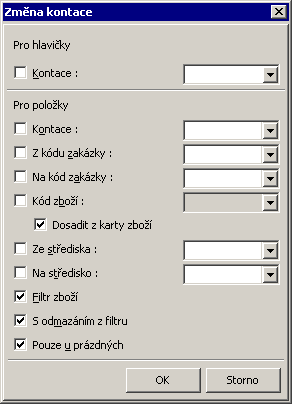
Picture: The Change Posting key form
Change Bits |
Opens the Change Attributes of Stock Documents form. After checking the Ignore Receipt Prices field, the Ignore Receipt Prices field will become checked on the 1stpage of the Transfer Notes that are selected in the filter. If you leave the field empty, the check of the Ignore Receipt Prices field will be removed at all documents selected in the filter. If you wish to change the check in confirmed documents, check the Also at Confirmed Documents (Even Superior Ones) field. |
Receipt Cards
Receipt Cards are documents that are used to receive goods to stock. As they are subordinate documents of the Purchase module, the description of Receipt Cards is not provided in this chapter. (For a detailed description, see the chapter Purchase - Receipt Cards.)
Release Notes
Release Notes are documents that are used to release goods from stock. As they are subordinate documents of the Purchase module, the description of Release Notes is not provided in this chapter. (For a detailed description, see the chapter Purchase - Release Notes..)
Job cards
Job Card is a document that allows you to plan the production of a specific article and to subsequently complete the production. Job Cards are used both in the planning of a production, and in the evaluation of completion of material standards, performance standards, and scheduled dates. A Job Card on one side performs the release of material from production warehouses and the consumption of performance; on the other side, it is used for the receipt of products or semi-finished products to a target warehouse (production one or other). A detailed description of a Job Card is provided in the Production - job card part).
ABC Analyses
The module of ABC Analyses consists of three parts:
- Configuration of ABC analyses;
- Calculation of ABC analyses;
- Book of ABC analyses.
The module enables you to evaluate a share of articles or customers in a followed value (e.g. turnover) and add records to a particular percentage group. At the same time, it offers a graphic view of followed values in history and the observation tendencies in comparison with previous calculated periods.
A final categorization into the ABC classes is saved into a header of an Article or a Customer card for a default analysis (determined on Article and Customer cards). Data from particular calculated configurations of ABC analyses can be found in the book of Articles on a new 'V' page, in the tab ABC Analyses, and in the book of Suppl./Cust. on the 'V' page.
You can make a calculation of ABC analysis directly in the book of ABC Analyses or run it as a function categorized in the Task Scheduler.
Note: The module of ABC analyses can also be used for a calculation of followed values without a requirement for element categorization into A, B, C groups. If the definition of groups is not set in a particular configuration, then only the calculation of followed values is running. Even in this case, the overview of processed elements (articles, customers) is in the calculated analysis.
Book of ABC Analyses
The book contains individual calculated configurations of ABC analyses. Each calculated analysis is identified by means of:
- an abbreviation and a name of analysis configuration;
- a period the analysis is calculated by.
Each calculated analysis contains the total value of a followed quantity and items included in groups according to cumulated percentage part of the followed quantity matching the definition of groups in the configuration of the analysis.
For each calculated analysis, the tendency of value development is displayed in addition to the analysis of the previous calculation of data (![]() ,
,![]() ,
,![]() ).
).
Current Analysis
Current analysis is always the last calculated analysis of each configuration. It is indicated by an icon of a black dot (![]() ). Only current analyses are displayed in the table in the book of Articles and in the book of Suppliers/Customers on the 'V' page. The result of a current analysis is also determinative for saving into an ABC class in the header of an Article card and a Customer card.
). Only current analyses are displayed in the table in the book of Articles and in the book of Suppliers/Customers on the 'V' page. The result of a current analysis is also determinative for saving into an ABC class in the header of an Article card and a Customer card.
Available Functions:
Calculate Analyses |
Opens a form for settings and running of analysis calculations. A closer description follows. |
Delete to Date |
Deletes analyses to a specified date. A Date To is evaluated. |
Delete Selected |
Analyses marked with an asterisk will be deleted. |
Configuration |
Opens a form to set analysis configurations. A closer description follows. |

Picture: ABC analyses - book
Folder 1 - Basic Data contains detailed information about an analysis value, about groups and tendencies. It consists of three parts:
Table of ABC Classes
It contains an overview of individual ABC classes: the total value of each group, the number of items in a group and a percentage part of a group on a complex.
Graphic expression of an analysis
Two pie charts demonstrate the share of individual groups in the result of an analysis: from the viewpoint of number of items and value.
History chart
Two line charts display the history of the development of the number of items and the total monitored value within a range of calculated analyses of a specific configuration. The red vertical line in the chart indicates the location of the current analysis on a timeline.
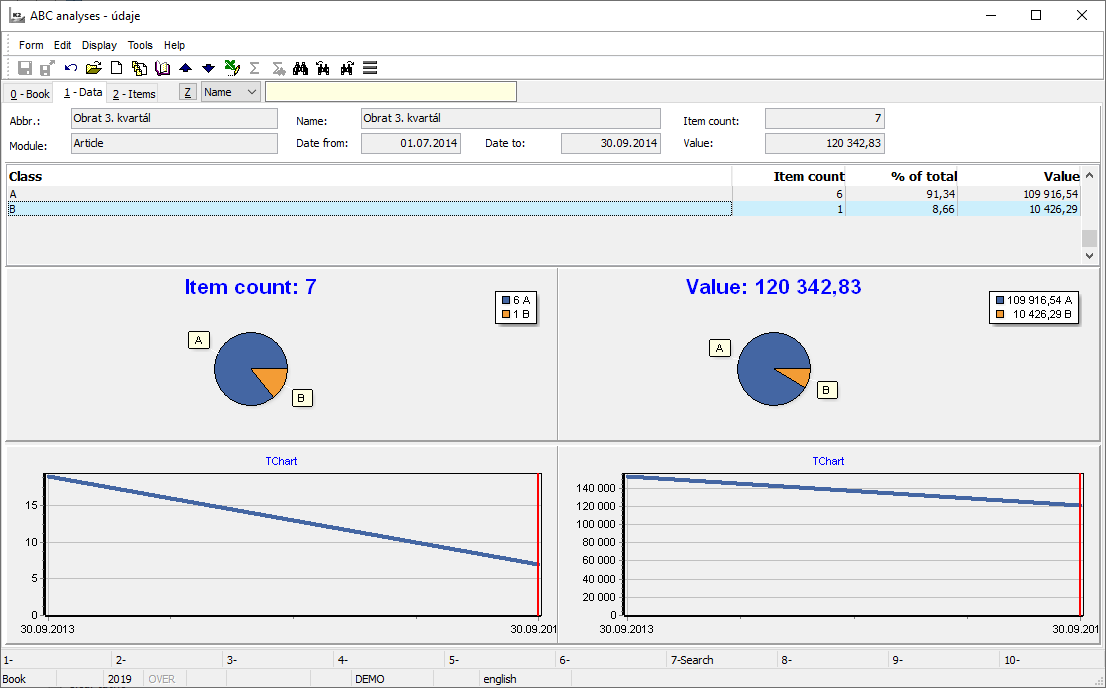
Picture: ABC Analyses - Basic Data
Folder 2 - Items contains the items of a calculated analysis. The folder shows data about the integration into an ABC class for each item, its percentage share in total value, the accumulated share in total value, the value of an item, and the tendency of the item in comparison to the previous analysis (![]() ,
,![]() ,
,![]() ). You can apply a filter on the items (right mouse button over the table - the Create Filter option (Shift+Ctrl+N)). You can create a container for the currently selected items or items manually marked with an asterisk (the Create Container button), or add items to an existing container of the corresponding module (the Add to Container button).
). You can apply a filter on the items (right mouse button over the table - the Create Filter option (Shift+Ctrl+N)). You can create a container for the currently selected items or items manually marked with an asterisk (the Create Container button), or add items to an existing container of the corresponding module (the Add to Container button).
In the lower part of the screen is a graphic expression of the history of the item's value within the calculated analyses of a given configuration. To watch and compare the history of the development of items, mark the items with an asterisk, and with the More Records in Chart option active, a series for the marked items will appear. The red vertical line in the chart indicates the location of the current analysis on a timeline.
You can monitor the adding of an Article or a Suppl./Cust. card to ABC classes for individual configurations and graphic expression of the development of a selected value in the tab V - Evaluation in particular books (sub-folder ABC Analyses in the book of Articles). You can switch to this folder by expanding the row of the item. A description of the tab may be found in the chapter Basic Code Lists and Supporting K2 Modules / Articles / Evaluation - Page V.
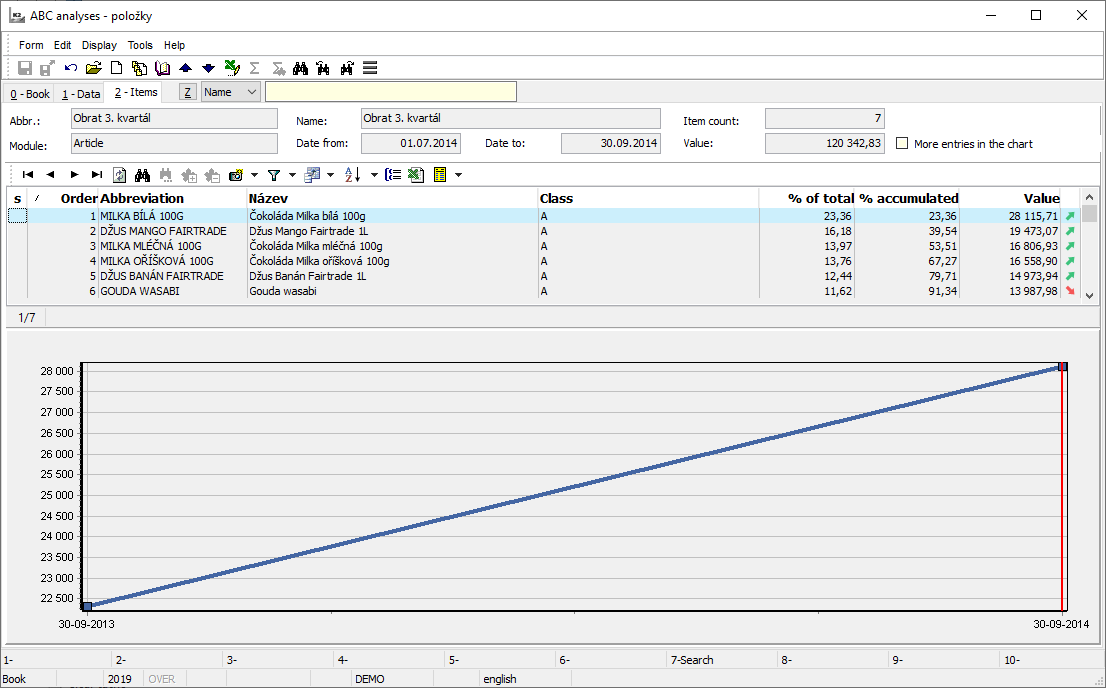
Picture: ABC Analyses - items
You can define individual types of analyses here. The individual configurations (analyses) can differ in the extent of data processed (in terms of time or content), followed values, summary (aggregation) functions, and by a target module. An example of this may be various configurations for branches (various books of documents are processed), configuration by period (monthly or weekly overviews), configurations evaluating articles or suppliers, etc.
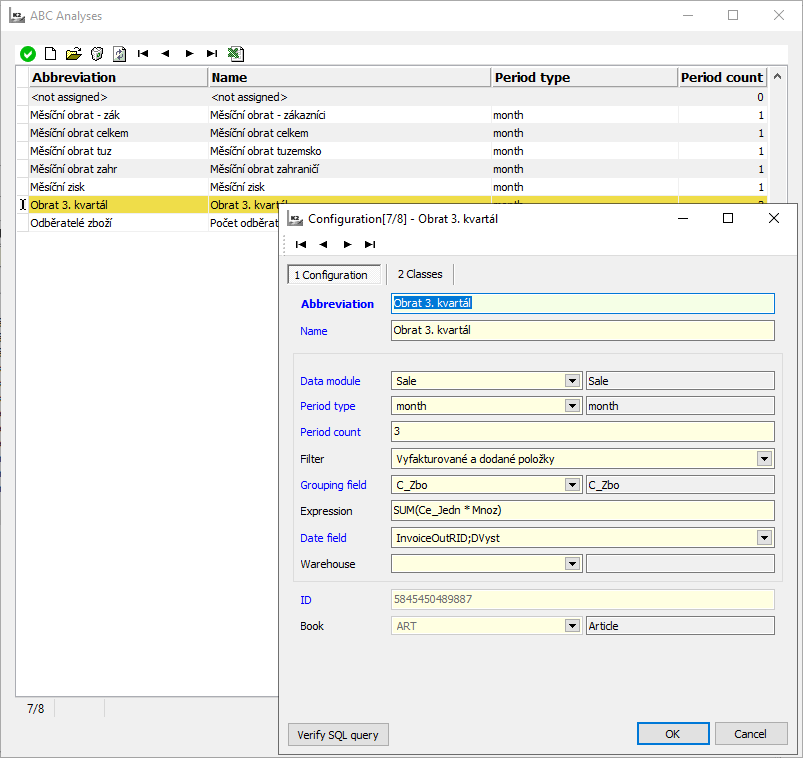
Picture: Configuration of ABC analyses
Folder 1- Configuration
Fields' Description:
Abbreviation, Name |
Configuration identification, mandatory abbreviation and name. |
Data module |
Data module for data loading. You can choose from:
|
Type of Period Number of Periods |
Use these fields to set the period for data loading during the calculation of values to the analysis calculation date. You can set these periods: day, week, month; further define the number of these periods. In the case of the Daily Stock Levels data module, the period type and the number of periods are pre-set by the system and cannot be changed (day, 1). Note: The date by which the analysis is calculated is set in the calculation of an analysis. Example: You want to calculate monthly turnovers. That is, you need to load monthly sales to a given date. Set the combination to 'month, 1'. |
Selection |
Selection for data extent determination (items which are going to be processed). |
Grouping Field |
Evaluate either Article cards or Suppl./Cust. cards. You can select an identification from a pre-set code list according to a field in books of items (for documents items that is 'C_ZBO' or 'MainCustomerId'). |
Term |
A term for the calculation of a value. The calculation runs on the server, you can use only database fields in the term (not calculated fields). As an aggregate function you can use functions such as SUM, COUNT, etc. Note: Function keywords must be written in capital letters. Note 2: The K2 data fields may be entered in two formats: a) simple entry of the name of a field; the term may not contain more than one group of brackets. B) the data field is surrounded by the '@' sign; the term may contain multiple brackets. Example 1: For a calculation of a turnover value from invoiced prices, the term would be: SUM(Quant * Ce_Jedn). Example 2: For a determination of the number of customers, the term would be: COUNT(DISTINCT MainCustomerId). Example 3: For a determination of released (selled and/or transferred) quantity, in the case of using the logistics item data module, the term would be: SUM(ReleaseQuantity) Example 4: The term for a calculation of turnover from items of Sale with multiple brackets: SUM((@Ce_Jedn@-@SkC@)*@Mnoz@) Note 3: If a date field in the term was in conflict due to multiple use in several data modules, you need to write 'K' in front of the data field. Example: If you want to calculate a turnover from sales, you need to use the 'SkC' field in the term. If the Items of Sale data module is set as a source, and you use a filter with the condition to the Articles data module, the conflict will occur (the 'SkC' field is both in the items of sale and the book of Articles). The term would be: SUM((@Ce_Jedn@-@SkC@)*@Mnoz@) The correctness of a term can be verified by the Test SQL Query button. |
Date Field |
Date field determines the time of a record. Example: If you evaluate the turnover of a sale, the data from confirmed invoices will be loaded. An accounting transaction date will be determinative for the classification of an invoice to a time period. Enter 'InvoiceOutRID;DVyst' into the date field. |
Stock |
A stock for the limitation of conditions of a selection. You can also enter summing stocks. |
Last Date |
A date to which the configuration was last calculated appears here. |
Default For |
The identification of a target data module (articles, suppl./cust.) is displayed here. |
Test SQL Query |
It verifies the validity of a term set in a Term field. |
Folder 2 - Groups
The A, B, C groups and their percentage value is defined here. In practice, the usual settings is: A = 80 %, B = 15 %, C = 5 %.
If the sum of values does not equal 100, the configuration cannot be calculated. If the groups are not defined at all, only the calculation of a following value without elements integrated into groups will be processed.
Analyses can be calculated from the book of ABC Analyses by means of the Calculate Analyses button or by integrating the function into the Task Scheduler. (A closer description about the assistant function is provided in the chapter Task Scheduler / Standard Actions.)
Two types of calculation with regard to the number of repetitions can be done:
- Calculation with repetition, which guarantees repeated loading for various periods. Example: once a year you will calculate a monthly turnover for the last year.
- One-time calculation for a one required period. Example: in the beginning of every month you will calculate the turnover for the previous month.
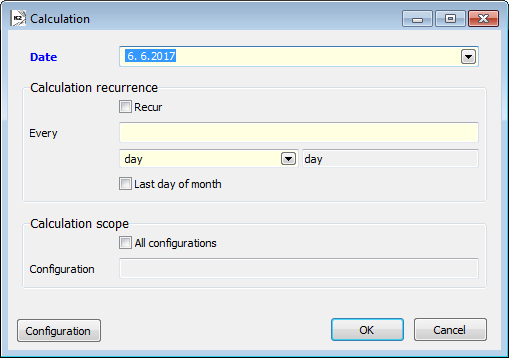
Picture: Calculate ABC analyses
Fields' Description:
Date |
The date, by which the analyses will be calculated. In the case of repeated calculation it is important to set the date of the first calculation. If the option Last Day of Month is activated in a setting of repetition, then the month and the year is important, not the day. |
|
Repeat Calculation |
Repeat |
Setting of a repeated calculation. The first analysis is done to the entered date, the last one to the last possible date before the current date of running. |
|
Every |
You can set the frequency of repetition here. You can select a day, a week, a month as a type of a repeated period. Example: You want to calculate weekly turnovers. Set the type of a period for 1 week in the configuration. The date is 05/01/2014 (Sunday). Set the repetition to 1 week as well. The first calculation will be on 05/01/2014 and it will contain the sales per a week (defined by the configuration). Another configuration will be on 12/01/2014 (defined by the frequency of repetitions) and for the entered week again (defined by the configuration), etc. |
|
Last Day of Month |
Defines that the analyses are always calculated to the last day of a month. Example: Calculate the monthly turnovers and have all of them by the last day of the month (to eliminate the shift of calculations because of differently long months). In a configuration, you can set the type of a period to '1 month'. The date is 01/01/2014. Activate this option. The first calculation will be on 31/01/2014, the second one on 28/02/2014. Due to a setting of period types, there always will be the 'date from' of the first day of a particular month in a configuration. |
Calculation Scope |
All Configurations |
By activating, we determine the calculation of all configurations. |
|
Configuration |
By means of Configurations button you can choose the particular configuration for a calculation (the selection is done by an activation of a checkbox in the list of configurations). |
Forecast of sales and supplies
On the basis of historical sales K2 programme enables to predict the future sales. Or it enables to predict the future consumption, suggest the extent of insurance reserves, the point of ordering and the extent of ordering amount. On the basis of this information it is important to calculate the development of supplies including the plan of date of the first order.
Characteristics of forecasts:
- Evaluation of individual Article cards.
- Two modes of supply suggestion: general (according to the settings of an Article card), via ordering calendar
- Creating of summing forecast views - in the book of Forecast Models.
- Individual settings on Article cards.
- Configurations of forecasts: sale / consumption, branch offices, stocks, forecasts for differently long periods, methods of data aggregation (allocation of aggregation results into days).
- Start forecasts over the book of Articles in bulk actions.
- Forecast action: the model setting, the forecast calculation, a plan of supplies.
- Forecast by means of R language: the most spread language for statistic calculations and data processing. Note: The R language must be enabled in the Firewall.
- Daily, weekly and monthly data aggregation.
- Data smoothing.
- The option of predicting and monitoring development of supplies based on the user estimate of sales / consumption.
- Graphic expression of results:
- for each Article card
- summing (e.g. for selected kinds of articles)
- display in financial values / in quantity
- daily / weekly / monthly aggregation, default aggregation according to a model
- User evaluation (via filters): e.g. an article that has a shortage in stock; articles that must be ordered till the entered date.
Article Card - V Page - Forecasts Folder
You can find the settings for particular Article cards, the final forecast model and a graphic expression of history and forecasts in the book of Articles, on the 'V' page of the Forecasts sub-folder.
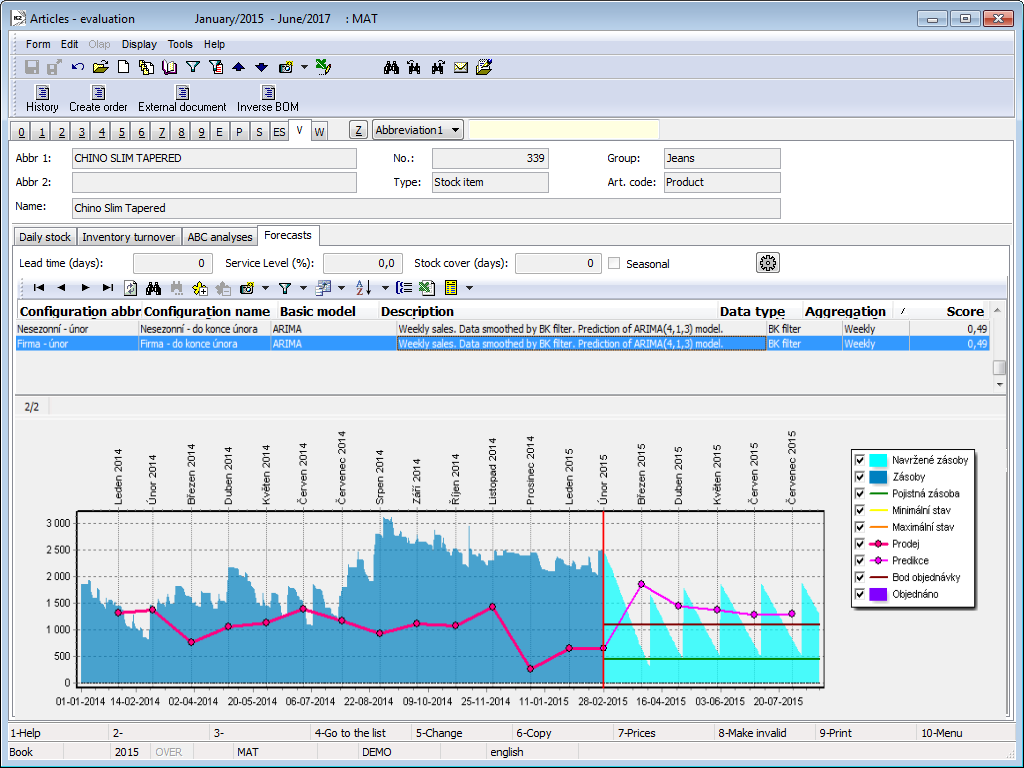
Picture: The Forecasts tab in the book of Articles
Fields' Description:
Lead Time (days) |
Delivery deadline of articles. In the meantime between a plan for an actual order and the delivery of articles, the system does not suggest any other orders. The value influences the calculation of the height of an insurance supply. |
Service Level (%) |
The ratio of demand satisfaction or the final articles availability. The value influences the calculation of the height of an insurance supply. |
Stock Cover (days) |
The time for which the supply should cover the predicted demand. The value influences the calculation of ordered quantity. |
Ordering Calendar |
Used for closer specification of suggesting supplies and ordering. A closer description is provided in the chapter Forecast Configuration. |
|
Forecast configuration. A closer description is provided in the chapter Forecast Configuration. |
Date From |
A date for the history display in a chart. |
Unit |
Stock unit of articles, in which we want to display the data. |
Display Amounts |
Displays values in financial part. It counts with a planned stock price of an article card. |
Daily / Weekly / Monthly / Default |
The selection of summation dealing with displays of sales / consumption (both actual and predicted values). In the case of weekly or monthly summations, the signs of particular months are located in a chart at the end of a period. “Default” summation meets the type of aggregation in a model. |
The resulting models for individual calculated configurations appear in a table above the chart. The final chart shows the currently selected record in the lower part.
Description of the chart:
Red vertical line |
Divides the actual facts (the left part of a chart) from the forecast part (the right part of a chart). Represents the day from which the forecasts are calculated. |
Dark blue |
A historical development of supplies in the stock (the reality). |
Dark pink |
An actual sale / consumption in history. |
Light blue |
A suggestion of supplies. |
Light pink |
Forecast of sales / consumptions. |
Green horizontal line |
An insurance supply (SS - Safety Stock). |
Brown curve |
A point of order (ROP - Reorder Point). The quantity at which the articles should be ordered. |
Violet |
Existing orders. Note: You can define types of coverage that create existing orders in the Forecast Configuration via the option Coverage Configuration. The ordered quantity from the coverage types 'In Receipt' and 'Received' is not entered into this series of the chart; the value is added to the supply levels to the first day of forecasts (because these types have a null date in the coverage). |
Light green |
Potential orders (orders suggested in the supplies suggestion). |
A yellow and orange line chart |
The height of minimum and maximum quantity in the stock from an Article card. |
Grey / black dashed curve |
The lower and upper bounds of intervals of forecast reliability. These sets are available only during the setting of a 'default' display of aggregation models. |
Forecast Configuration
The configuration of predictions can be called up using the button ![]() on the "In" side in the Article book, on the Predictions sub-tab. With the use of a configuration,you can predict e.g. for differently long periods, for various branch offices, stocks, etc.
on the "In" side in the Article book, on the Predictions sub-tab. With the use of a configuration,you can predict e.g. for differently long periods, for various branch offices, stocks, etc.
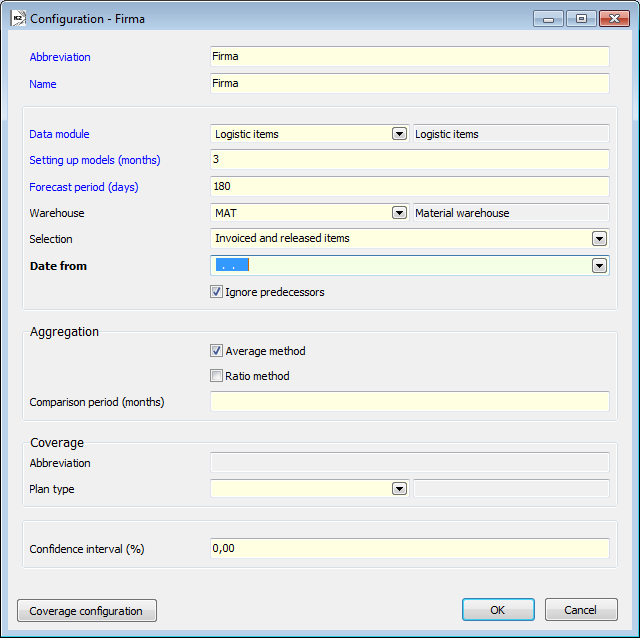
Picture: Forecast Configuration
Fields' Description:
Abbreviation, Name |
Identification of a configuration. |
|
Data module |
Module selection for Forecasts:
|
|
Setting up Models (months) |
Number of months from a date the forecasts are counted by (the date is set in the Run Forecasts function) is set for a period in which comes a comparison between the future sales (consumption) and actual sales (consumption), and a selection of the best forecast model. A description may be found in the chapter Run Forecasts. |
|
Forecast Period (days) |
Number of days that the forecasts are created for. |
|
Stock |
Sales forecasts: a stock where the sales are loading as actual historical sales. If there is no filter (in the Filter field), the items from the confirmed released notes from this stock will be loaded. Forecast of consumption: a stock where the consumption are loading as real historical sales. If there is no filter selected (in the Filter field), the items from confirmed Job Cards from this stock will be loaded. (Attention: the filter of Job Cards is necessary in the case of the planning / completing methodology of a Job Card. Otherwise the consumption is loaded twice.) If a filter is selected, the condition is always added to a defined stock. |
|
Filter |
A filter from Sale Items / Production Items for a determination of actual sales (consumptions) that will be processed. The filter is always extended by a condition to stock (entered in the Stock field). The setting of a filter is not compulsory (see description in the Stock field). |
|
Date From |
Date from which the actual sales (consumption) are loaded in the history. |
|
Ignore Predecessors |
Yes - in calculations, the succession of the Article cards is ignored (set on the 4th page of an Article card) No - sales (consumptions) and states of card supply levels contain the data of a forerunner (or rather of all forerunners in the tree of the forerunners). The end date of validity of a card is not taken into consideration. |
|
Aggregation |
Here you can define aggregation values of sales / consumptions (monthly, weekly) forecasts, which are divided into individual days. Explanation: The amount of forecast sales (consumptions) is always saved in the database on a daily base. However, the forecast model can return even the aggregated values (according to the structure of historical sales / consumptions). You need to re-divide them into days after saving them. |
|
Average Method |
This calculates an average per day from an aggregated value. Example: A monthly calculated forecast for September is 90 pieces. Daily value is 90/30, i.e. 3 pieces per day. |
|
Ratio Method |
The method finds out the ratio of a sale on a particular day in an aggregated period to the total sales in the evaluated period (see field below). This ratio will then divide the aggregated value into days. Example: A monthly calculated forecast for September is 90 pieces. The period for comparison is set to 24 months. For a daily value of forecast on September 1st, a percentage of sales per the 1st day of months in the compared period to the total sales per 24 months will be found. Suppose that on the first day of months 2% of sales are sold. The value 1,8 pieces is calculated for September 1st.
Example2: A weekly calculated forecast for the first September week of 2015 is 90 pieces. The period for comparison is set to 6 months. For a daily value of a forecast on September 1st (Tuesday), it is found out that the percentage of a sale is always on Tuesdays during the previous 6 months to the whole sale in this period. Suppose that in the first day of months 15 % of sales are sold. The value of 13,5 pieces is calculated for Tuesday September 1st. |
|
Periods to Compare (months) |
The length of a period in the past where the calculations of sales ratio for particular days are done given to the total sales in this period. This settings apply to the ratio method. |
|
Coverage - Plan type, Coverage Configuration |
By means of a Plan type and a selection of Coverage Configuration, you can influence the existing orders from the Coverage function. A closer description is provided in the chapter Article Card - V Page - Forecasts Folder in the section Chart Description. |
|
Confidence Interval (%) |
The lower and the upper limit of forecast sales can be calculated by means of the confidence interval. It determines the probability of future sales ratio between the lower and the upper limit. The extent of reliability should be within 50 to 99%. The higher a confidence interval, the higher the difference between the lower and the upper limit of a forecast will be. |
|
Run Forecasts
The function for a forecast run is in the menu Form / Bulk Actions / Run Forecasts in the book of Articles. It is available only if the R Language has been installed together with the K2 programme (this installation can be selected during the installation of the K2 product).
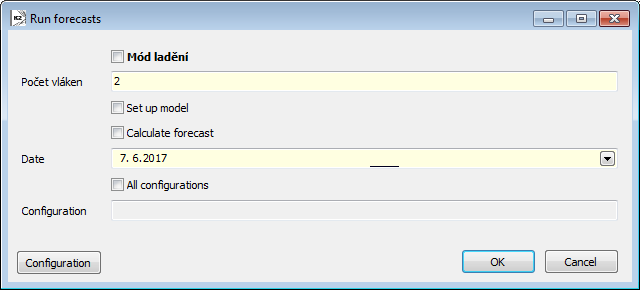
Picture: The form for running of a forecast calculation
Fields' Description:
Debug Mode |
This mode is set for debugging (e.g. creating supporting files). |
Thread Count |
The number of threads for parallel processing (default value = 4). |
Setting Up Models |
For each processed Article card, the programme selects the most suitable forecast model based on actual sales. Actual sales are loaded in the interval of: - from the date set in a configuration in the field Date From - to the date the forecast is calculated (set in this form in the field Date). The date is cut short of the number of months set in a configuration in the field Setting Up Models (months). The forecast is suggested based on this history. It is compared with the actual sales in the period which is reserved for model settings. The model that is the closest to actual sales is selected as the best model, and it will serve as a base for the calculation of future sales forecasts. If no model is found, or not enough historical data exist for a forecast calculation, you can delineate the future development (of sales and supply) by the user estimate of sales / Consumption Those are entered on page 4 of an Article card, table Articles / Stock Data, field Estimated Releases for Period. |
Calculate Forecast |
A calculation of a future sales forecast based on the best model or an estimate of sales / consumptions (see above) and a calculation of safety stock levels, ordering point, a calculation of supply level, and a suggestion of quantity to be ordered. |
Supply Suggestion |
|
Date |
A date the forecasts are calculated from (to). |
Configurations / All Configurations |
The selection of configuration / forecast configurations that are going to be processed. |
 .
.